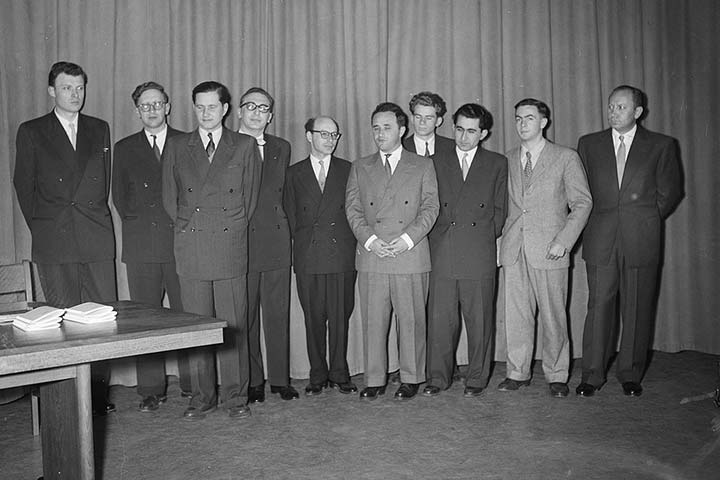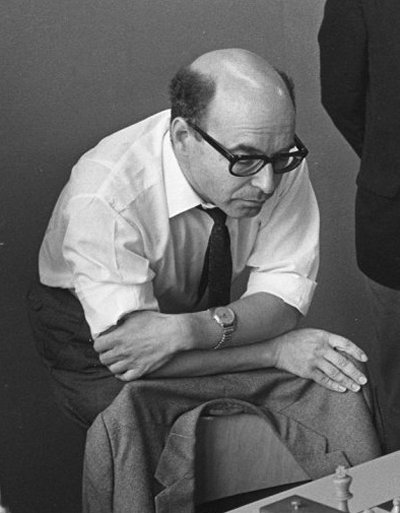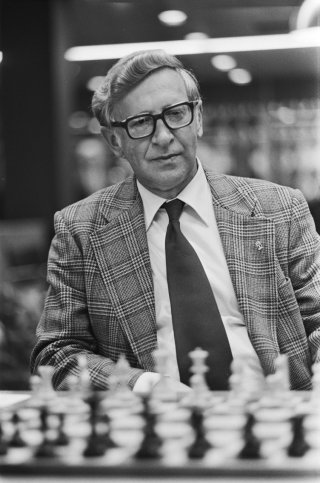


ChessBase 17 - Mega package - Edition 2024
It is the program of choice for anyone who loves the game and wants to know more about it. Start your personal success story with ChessBase and enjoy the game even more.
For a long time, the world chess title was a private affair and the reigning World Champion could choose when and against whom he wanted to risk his title. In 1946, Alexander Alekhine had died as the reigning world champion and FIDE took over responsibility for organising the World Championships. This started with the world championship tournament in Moscow and The Hague which was won by Mikhail Botvinnik. From then on, the world champion would have to defend his title every three years though not against a player of his choice but against the winner of candidates tournaments in which the best players of the world would fight for the right to challenge the world champion.
The first official candidates tournament took place in Budapest, in 1950. Ten players started in a double-round-robin, organised by FIDE. However, this first tournament was not decided by strong play alone. After 18 rounds the Soviet players Isaak Boleslavsky and David Bronstein shared first place with 12.0 / 18 each, but Bronstein later admitted that the tournament finish was manipulated. After 16 rounds, Boleslavsky was sole leader and one point ahead of Bronstein but then he slowed down. In round 17, he drew with Alexander Kotov and in the final round, he made a quick draw against Gideon Stahlberg from Sweden, one of the weaker players in the field. This allowed Bronstein to catch up. He won in round 17 against Stahlberg and in the final round defeated Paul Keres:
| Rg. | Name | 1 | 2 | 3 | 4 | 5 | 6 | 7 | 8 | 9 | 10 | Pts. |
| 1 | David Ionovich Bronstein | ½½ | 10 | 1½ | 11 | 1½ | 01 | ½½ | 1½ | 1½ | 12.0 / 18 | |
| 2 | Isaak Boleslavsky | ½½ | 1½ | ½½ | ½½ | 1½ | ½½ | 1½ | ½1 | 11 | 12.0 / 18 | |
| 3 | Vassily V Smyslov | 01 | 0½ | ½½ | ½1 | 1½ | 10 | ½1 | ½½ | ½½ | 10.0 / 18 | |
| 4 | Paul Keres | 0½ | ½½ | ½½ | ½½ | 10 | ½1 | ½½ | ½1 | ½½ | 9.5 / 18 | |
| 5 | Miguel Najdorf | 00 | ½½ | ½0 | ½½ | ½½ | ½½ | 11 | ½1 | ½½ | 9.0 / 18 | |
| 6 | Alexander Kotov | 0½ | 0½ | 0½ | 01 | ½½ | ½1 | 10 | 10 | ½1 | 8.5 / 18 | |
| 7 | Gideon Stahlberg | 10 | ½½ | 01 | ½0 | ½½ | ½0 | ½½ | ½½ | ½½ | 8.0 / 18 | |
| 8 | Andor Lilienthal | ½½ | 0½ | ½0 | ½½ | 00 | 01 | ½½ | 01 | ½½ | 7.0 / 18 | |
| 9 | Laszlo Szabo | 0½ | ½0 | ½½ | ½0 | ½0 | 01 | ½½ | 10 | 01 | 7.0 / 18 | |
| 10 | Salo Flohr | 0½ | 00 | ½½ | ½½ | ½½ | ½0 | ½½ | ½½ | 10 | 7.0 / 18 |
Bronstein and Boleslavsky might have hoped that the tie in the candidates tournament would lead to a three-player world championship match between Botvinnik, Bronstein and Boleslavsky but of course, Botvinnik was not particularly fond of this idea. Therefore, Bronstein and Boleslavsky, who were close friends and training partners — Bronstein later even married Boleslavsky's daughter Tatjana — were forced to play a tie-break to establish the challenger. Bronstein won this play-off which in all likelihood had also been pre-arranged.
In a confidential conversation with his fellow Minsk resident and favourite pupil Albert Kapengut, Boleslavsky admitted that just a few of those games were genuine, and to make the last game more convincing the players even had to employ a novelty that they had discovered. (Genna Sosonko, The Rise and Fall of David Bronstein, Elk and Ruby 2017, p. 50)
However, these manipulations brought Bronstein no luck. In 1951, he played a world championship match against Botvinnik but missed the title by half a point (the match ended in a 12 : 12 tie and because the challenger as challenger had to score at least 12½ points Botvinnik defended his title) and this missed chance haunted Bronstein for the rest of his life.

David Bronstein 1968 | Photo: Eric Koch / Anefo CC BY-SA 3.0 via Wikimedia Commons
In 1953, three years after the tournament in Budapest, the second candidates tournament took place in Zurich. It was a gigantic event: 15 participants played a double-round-robin, that is, each participant had to play 28 games. Zurich 1953 is still one of the most famous tournaments in chess history, not least because of the legendary tournament book by Bronstein which many chess players consider to be one of the best chess books ever written. But though Bronstein is officially the author of this chess classic the idea to this book goes back to Bronstein's mentor Boris Vainshtein, a high-ranking and influential KGB officer. Vainshtein also wrote "the entire narrative part", Bronstein contributed only the analyses. (Cp. Sosonko, The Rise and Fall, p. 139)
This tournament book made some of the games played in Zurich 1953 famous. For example Euwe's win against Efim Geller, in which the former Dutch world champion comes up with one of the most stunning rook sacrifices in chess history:
Learning from the World Champions
With famous classical examples from the works of the giants, the author talks in detail about principles of chess and methods of play that we can use during every stage of the game.
Another legendary game is Kotov's win against Yuri Averbakh in which the black queen sacrifices itself to question the white king deep in Black's camp.
But in Zurich Bronstein could not repeat his success from Budapest. He scored 16.0 / 28 to share second to fourth place with Keres and Samuel Reshevsky. The tournament was won by Vassily Smyslov.
Chess Tactics are the art of combat command. When tactics dominate concrete action is required immediately in order to put a plan into practice or to grab an opportunity. However in complicated positions and with determined resistance basic tactics are often insufficient and intuition, imagination and precision are necessary.
| Rg. | Name | 1 | 2 | 3 | 4 | 5 | 6 | 7 | 8 | 9 | 10 | 11 | 12 | 13 | 14 | 15 | Pts. |
| 1 | Vassily V Smyslov | 11 | ½½ | ½1 | ½½ | ½½ | 11 | ½0 | ½½ | ½½ | ½½ | ½½ | 1½ | 11 | 1½ | 18.0 / 28 | |
| 2 | Paul Keres | 00 | 0½ | ½½ | ½1 | ½½ | ½1 | ½½ | ½½ | 0½ | 11 | 1½ | ½1 | ½½ | 11 | 16.0 / 28 | |
| 3 | David Ionovich Bronstein | ½½ | 1½ | 11 | ½½ | ½½ | ½0 | ½½ | 1½ | ½½ | ½½ | 01 | 1½ | ½½ | ½½ | 16.0 / 28 | |
| 4 | Samuel Herman Reshevsky | ½0 | ½½ | 00 | ½½ | ½½ | ½½ | 10 | ½½ | ½1 | ½1 | 1½ | ½1 | 11 | 1½ | 16.0 / 28 | |
| 5 | Tigran V Petrosian | ½½ | ½0 | ½½ | ½½ | 0½ | ½½ | ½½ | 00 | ½½ | ½½ | 11 | ½1 | 1½ | 11 | 15.0 / 28 | |
| 6 | Miguel Najdorf | ½½ | ½½ | ½½ | ½½ | 1½ | 00 | 1½ | 1½ | ½0 | ½½ | ½½ | ½½ | 0½ | 11 | 14.5 / 28 | |
| 7 | Efim P Geller | 00 | ½0 | ½1 | ½½ | ½½ | 11 | ½0 | 01 | ½½ | 01 | 1½ | ½1 | 01 | ½½ | 14.5 / 28 | |
| 8 | Alexander Kotov | ½1 | ½½ | ½½ | 01 | ½½ | 0½ | ½1 | 10 | 1½ | 00 | 10 | 1½ | 0½ | 01 | 14.0 / 28 | |
| 9 | Mark E Taimanov | ½½ | ½½ | 0½ | ½½ | 11 | 0½ | 10 | 01 | 10 | ½½ | ½½ | ½0 | 0½ | 11 | 14.0 / 28 | |
| 10 | Yuri L Averbakh | ½½ | 1½ | ½½ | ½0 | ½½ | ½1 | ½½ | 0½ | 01 | ½½ | ½½ | 0½ | 11 | 00 | 13.5 / 28 | |
| 11 | Isaak Boleslavsky | ½½ | 00 | ½½ | ½0 | ½½ | ½½ | 10 | 11 | ½½ | ½½ | ½0 | ½½ | ½1 | ½½ | 13.5 / 28 | |
| 12 | Laszlo Szabo | ½½ | 0½ | 10 | 0½ | 00 | ½½ | 0½ | 01 | ½½ | ½½ | ½1 | 1½ | ½½ | 1½ | 13.0 / 28 | |
| 13 | Svetozar Gligoric | 0½ | ½0 | 0½ | ½0 | ½0 | ½½ | ½0 | 0½ | ½1 | 1½ | ½½ | 0½ | ½1 | 11 | 12.5 / 28 | |
| 14 | Max Euwe | 00 | ½½ | ½½ | 00 | 0½ | 1½ | 10 | 1½ | 1½ | 00 | ½0 | ½½ | ½0 | 1½ | 11.5 / 28 | |
| 15 | Gideon Stahlberg | 0½ | 00 | ½½ | 0½ | 00 | 00 | ½½ | 10 | 00 | 11 | ½½ | 0½ | 00 | 0½ | 8.0 / 28 |
However, Smyslov failed to overcome Botvinnik: just like Bronstein in 1951 he "only" tied the world championship match 1954 against Botvinnik and Botvinnik once again narrowly defended the title.
Missing the title narrowly must have been a bitter disappointment for Smyslov but he did not lose heart. After winning the candidates tournament in Zürich 1953 he also won the next candidates tournament in Amsterdam 1956 — a remarkable success.
| Rg. | Name | 1 | 2 | 3 | 4 | 5 | 6 | 7 | 8 | 9 | 10 | Pts. |
| 1 | Vassily V Smyslov | ½½ | ½½ | 0½ | ½1 | ½½ | 11 | ½1 | ½1 | ½1 | 11.5 / 18 | |
| 2 | Paul Keres | ½½ | ½½ | ½½ | 1½ | ½½ | ½½ | ½0 | 1½ | 1½ | 10.0 / 18 | |
| 3 | Tigran V Petrosian | ½½ | ½½ | ½½ | ½0 | ½½ | 01 | 1½ | ½½ | 1½ | 9.5 / 18 | |
| 4 | Boris Vasilievich Spassky | 1½ | ½½ | ½½ | ½1 | ½0 | ½0 | ½½ | ½½ | 1½ | 9.5 / 18 | |
| 5 | David Ionovich Bronstein | ½0 | 0½ | ½1 | ½0 | ½½ | 1½ | 1½ | ½½ | 1½ | 9.5 / 18 | |
| 6 | Laszlo Szabo | ½½ | ½½ | ½½ | ½1 | ½½ | 1½ | 0½ | ½½ | 01 | 9.5 / 18 | |
| 7 | Efim P Geller | 00 | ½½ | 10 | ½1 | 0½ | 0½ | 11 | 1½ | 1½ | 9.5 / 18 | |
| 8 | Miroslav Filip | ½0 | ½1 | 0½ | ½½ | 0½ | 1½ | 00 | 01 | 1½ | 8.0 / 18 | |
| 9 | Oscar Panno | ½0 | 0½ | ½½ | ½½ | ½½ | ½½ | 0½ | 10 | 1½ | 8.0 / 18 | |
| 10 | Hermann Pilnik | ½0 | 0½ | 0½ | 0½ | 0½ | 10 | 0½ | 0½ | 0½ | 5.0 / 18 |
Smyslov lost only one game in Amsterdam – against the 19-year old Spassky who made his first attempt to become world champion. In the end, Spassky shared third to seventh place but after this promising beginning, another nine years should pass before Spassky became a candidate again after sharing first to fourth place at the Interzonal Tournament 1964 in Amsterdam.

In Amsterdam 1956 Smyslov was particularly successful against his fellow Soviet player Efim Geller — Smyslov won 2-0. In candidates tournaments Geller always had problems against Smyslov: they played four games in two candidates tournaments against each other and Smyslov won all four of them. In other events Geller fared much better against Smyslov: the ChessBase Mega Database contains 56 games of Geller vs Smyslov. Geller won 11, Smyslov 8, 37 ended in a draw. And in their candidates match 1965 Geller was almost as dominant as Smyslov had previously been in the candidates tournaments: Geller won the match 5½ : 2½ (3 wins, 5 draws).
Winning his second candidates tournament in a row gave Smyslov to play another world championship match against Botvinnik in 1957. Smyslov's second attempt went much better than the first and he won the match 12½-9½ and became new World Champion. However, his luck did not last long because in the return match in 1958 Botvinnik regained the title with a 12½-10½ win. Botvinnik was world champion again and Smyslov had to play another candidates tournament — in Yugoslavia 1959.
Vassily Smyslov 1977 | Photo: Koen Suyk, via Wikimedia Commons)
Next: the candidates tournaments 1959 and 1962...